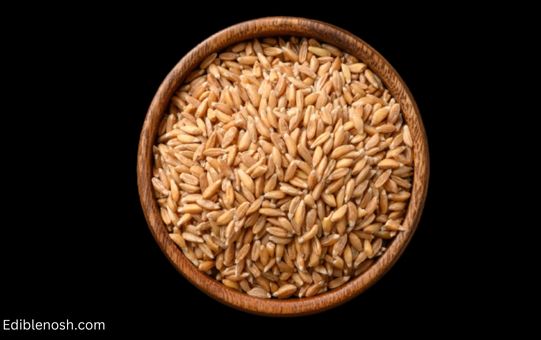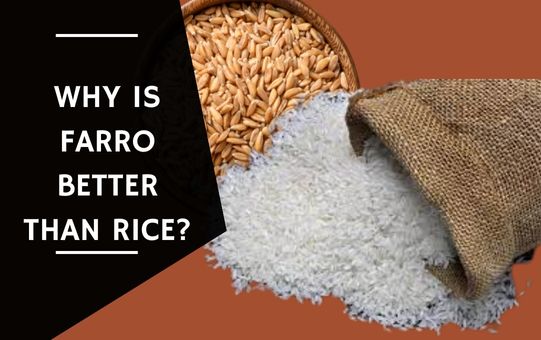Are you sick of eating the same rice dishes? Farro, an ancient grain that has been gaining in popularity, may be a good choice for a change of pace. However, why is farro better than rice?
Want a healthier grain alternative? Farro is a nutrient-dense, eco-friendly alternative to rice that provides numerous health benefits. It is rich in fiber, protein, and nutrients, making it an excellent option for those seeking to enhance their overall health. Additionally, farro is versatile and can be utilized in a variety of dishes.
Read on to discover the health benefits of this delicious grain and why it may be a better option for your meals.
Contents
Why Farro is better than rice matter?
There are several reasons why choosing farro over rice can be a beneficial decision.
First and foremost, farro is a whole grain, meaning that it has not been processed or stripped of its nutrients. Unlike white rice, which is stripped of its bran and germ during the milling process, farro retains its fiber, vitamins, and minerals. This makes farro a more nutritious option than white rice, as it contains more protein, fiber, and nutrients.
In addition to its nutritional benefits, farro is also a sustainable grain to grow and harvest. It requires less water and pesticides than other grains, making it a good choice for those who are environmentally conscious.
Farro is also versatile and can be used in a variety of dishes, including salads, soups, and grain bowls. It is a good alternative to rice in dishes like risotto or pilaf and can add a nutty flavor and chewy texture to meals.
Read Also: Why Is Farro So Expensive?
What Is Farro?
Farro is an ancient grain that has been cultivated for thousands of years. It is a type of wheat, and it is often referred to as “emmer wheat.” Farro has a chewy texture and a nutty flavor, and it is often used in salads, soups, and grain bowls.
One of the key benefits of farro is that it is a whole grain, meaning that it has not been processed or stripped of its nutrients. Unlike white rice, which is stripped of its bran and germ during the milling process, farro retains its fiber, vitamins, and minerals. This makes farro a more nutritious option than white rice.
Farro is also naturally gluten-free, although it is often processed in facilities that also handle wheat, so it is important to check the label if you are sensitive to gluten.

Nutritional Comparison: Farro vs. Rice
So, what makes farro a better choice than rice when it comes to nutrition? Let’s take a closer look at the nutritional breakdown of both grains:
- Farro: One cup of cooked farro contains approximately 185 calories, 6 grams of protein, 39 grams of carbohydrates, and 4 grams of fiber. It is also a good source of iron, zinc, and B vitamins.
- White rice: One cup of cooked white rice contains approximately 205 calories, 4 grams of protein, 45 grams of carbohydrates, and 0.6 grams of fiber. It is also a good source of thiamin and niacin, but it is not as high in other nutrients as farro.
As you can see, farro contains more protein, fiber, and nutrients than white rice. It is also lower in calories and carbohydrates, making it a good choice for people looking to manage their weight or blood sugar levels.
On the other hand, brown rice is a healthier option than white rice, as it is a whole grain and contains more fiber and nutrients. However, farro still has more protein, fiber, and nutrients than brown rice, making it a more nutrient-dense option.
Difference between Farro and Rice
Here is a different table comparing farro and rice:
| Feature | Farro | Rice |
| Type of grain | Wheat | Oryza sativa |
| Nutritional value | High | Moderate to low |
| Fiber content | High | Low (except brown) |
| Protein content | High | Low (except brown) |
| Versatility | High | Moderate |
| Gluten-free | Naturally (but may be processed with wheat) | Moderate |
As you can see, farro is a more nutritious and versatile grain than rice, especially when compared to white rice. Brown rice is a healthier option than white rice, but farro still has more protein, fiber, and nutrients, making it a more nutrient-dense choice.
Farro is also naturally gluten-free, although it may be processed in facilities that also handle wheat, so it is important to check the label if you are sensitive to gluten.
Benefits of Farro
So, why is farro a better choice than rice? Here are a few key benefits:
- High in fiber: Farro is a good source of fiber, which is important for maintaining a healthy digestive system and aiding in weight management.
- Good for blood sugar control: The high fiber content of farro can also help to regulate blood sugar levels and reduce the risk of type 2 diabetes.
- Heart-healthy: Farro is a good source of antioxidants and has been shown to lower cholesterol levels and improve heart health.
- Versatile: Farro can be used in a variety of dishes, including salads, soups, and grain bowls. It is also a good alternative to rice in dishes like risotto or pilaf.
- Sustainable: Farro is a sustainable grain to grow and harvest, as it requires less water and pesticides than other grains.
Read Also: Can I Substitute Farro For Pearl Barley?
Conclusion
Farro is a nutritious and sustainable alternative to rice that offers a range of health benefits. It is a whole grain that is high in fiber, protein, and nutrients, making it a good choice for people looking to improve their overall health.
Farro is also versatile and can be used in a variety of dishes, making it a great option for those looking to incorporate more whole grains into their diet. While brown rice is a healthier option than white rice, farro still has more protein, fiber, and nutrients, making it a more nutrient-dense choice. So, if you’re looking for a healthier grain option, consider giving farro a try!
FAQS | Why Farro is better than rice?
Here are five relevant FAQs for the topic of Why Is Farro Better than Rice?:
What Is Farro And How Is It Different From Rice?
Farro is an ancient grain that has been cultivated for thousands of years. It is a type of wheat, and it is often referred to as “emmer wheat.”
Farro has a chewy texture and a nutty flavor, and it is often used in salads, soups, and grain bowls. Unlike white rice, which is stripped of its bran and germ during the milling process, farro is a whole grain that retains its fiber, vitamins, and minerals.
Is Farro A Healthier Option Than Rice?
Farro is generally considered a healthier option than rice, especially when compared to white rice. Farro is a whole grain that is high in fiber, protein, and nutrients, making it a good choice for people looking to improve their overall health.
It is also lower in calories and carbohydrates than white rice, making it a good choice for people looking to manage their weight or blood sugar levels.
Can I Use Farro As A Substitute For Rice In Recipes?
Yes, farro can be used as a substitute for rice in many recipes. It has a chewy texture and a nutty flavor that works well in salads, soups, and grain bowls. Farro is also a good alternative to rice in dishes like risotto or pilaf. Just be aware that farro takes longer to cook than rice, so you may need to adjust the cooking time accordingly.
Is Farro Gluten-Free?
Farro is naturally gluten-free, although it is often processed in facilities that also handle wheat. If you are sensitive to gluten, it is important to check the label to ensure that the farro you are purchasing has not been contaminated with wheat.
Is farro a sustainable grain option?
Yes, farro is a sustainable grain to grow and harvest. It requires less water and pesticides than other grains, making it a good choice for those who are environmentally conscious.

